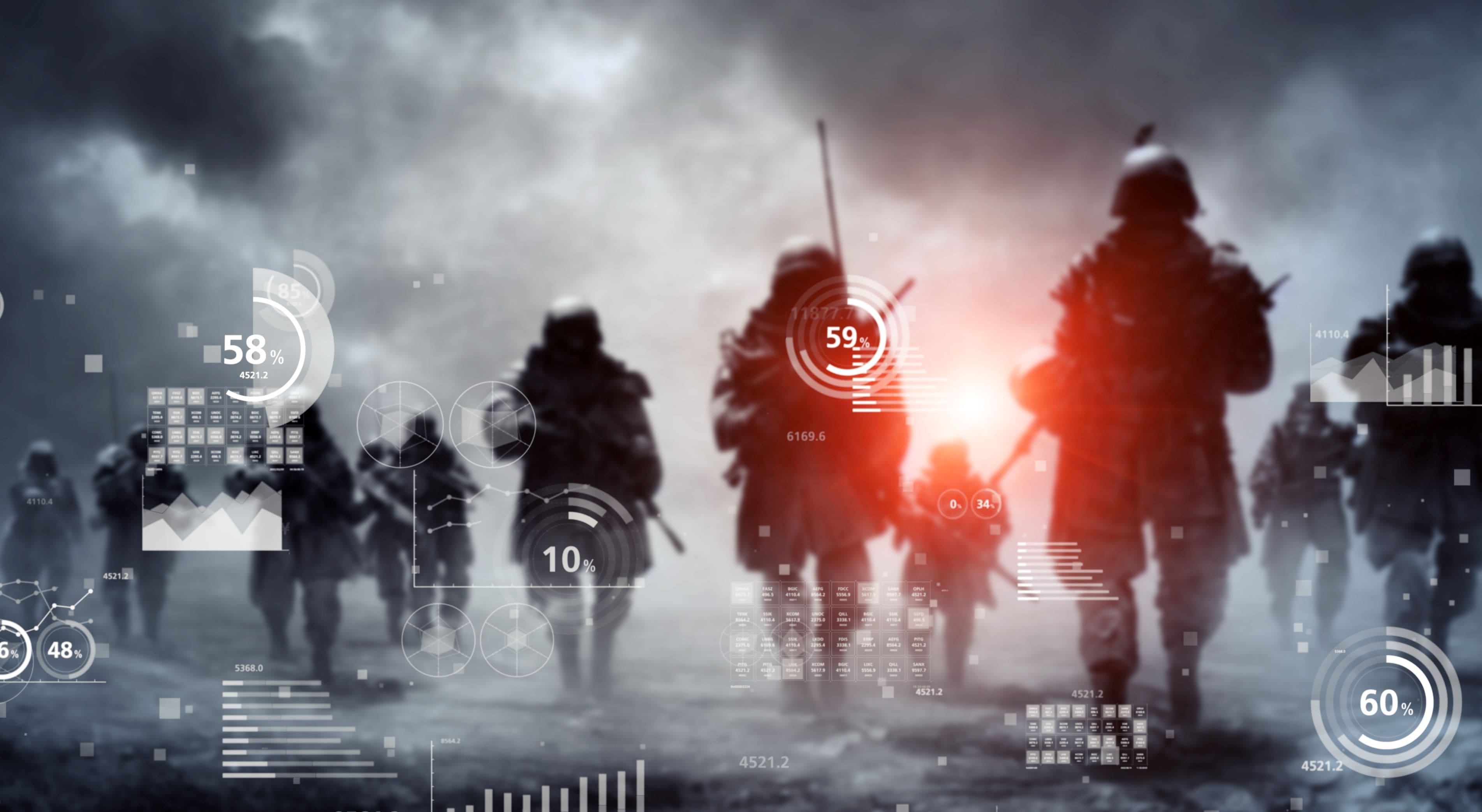Artificial intelligence has become ubiquitous in a wide range of global industries, from healthcare to automotive to online shopping. As AI continues to enjoy commercial success, governments and militaries around the world are increasing their investments in AI due to its enormous potential to save time, money, and lives.
From low-latency intelligent video analytics to quantum computing to predictive maintenance, AI is currently being used to assist militaries in all phases of warfare including logistics, surveillance, cybersecurity, tactical decision-making, target identification, autonomous vehicles, guided munitions, and lethal autonomous weapon systems. In this article, we’ll discuss the challenges facing militaries when adopting AI, the market value of AI military applications, and various technologies and trends that are significantly impacting the way militaries operate.
Challenges Facing Military AI Adoption
Whereas AI development in the 1950s and 1960s was driven by a combination of government funding, academics, and private institutions, today the commercial sector has taken the lead. According to Dr. Tien Pham, chief scientist of the computational and information sciences directorate, U.S. Army Combat Capabilities Development Command Army Research Laboratory, the commercial sector leads AI development today, which means the military is often lagging behind. There are several reasons for this:
- The success of AI in commercial sectors is based on the availability of copious amounts of data and, of course, the ability to analyze that data. Due to the secretive nature of the military, it lacks the same amount of data, which makes building AI engines difficult.
- Even when data is available, militaries are reluctant to share it with private companies, often the owners of AI technology.
- At the same time, private companies aren’t always eager to share their patented AI products with governments and militaries. This makes it hard for militaries to gain access to prevalent and up-to-date AI technologies.
- The stakes in the military are much higher than many widespread commercial AI applications, like retail or marketing, which automatically makes adoption slower.
Military AI Market Growth and Potential
Despite the challenges facing the adoption of AI technology in the military, the industry is growing at a robust rate, mainly because professionals realize that AI is the future of all industries. According to a recent MarketsandMarkets report, the military AI industry reached approximately $9.2 billion in 2023 and is expected to grow to $38.8 billion by 2028, more than quadrupling its value in a span of just five years.
5 AI Technologies and Trends Changing the Face of the Military
While AI might seem like a relatively new phenomenon, the U.S. Department of Defense (DoD) has been using it since the 1950s. In 2014, the DoD published its Third Offset Strategy, which promoted a shift in focus from legacy hardware like tanks, planes, etc. to software, ultimately paving the way for the adoption of AI.
Here are 5 areas in which AI is making a significant impact in the defense and military industries. We can expect to see these technologies becoming more prevalent and advanced with each passing year.
Intelligent Video Analysis
According to a GlobalData Report, intelligent video analytic solutions are a “key innovation area” for military use of AI. Solutions that offer high video quality, low latency, multiple streams, and robust communication are ideal for supporting military surveillance, including streaming, data processing and interpretation, pattern recognition, face and object identification, and more.
For example, AI video analysis has been used heavily in the Russia-Ukraine War for geospatial intelligence, analyzing not only satellite images but also social media and internet data posted in sensitive locations. In fact, Ukraine’s deputy minister of digital transformation, George Dubynskiy, attributed the country’s strong defense to its decision to invest heavily in military AI.
Edge AI
Edge computing was developed by a group of computer scientists from MIT who founded a private company, Akamai, in the late 1990s. Its creation eliminated the need for centralized servers and keeps data closer to their sources. Edge computing is characterize by low-latency, scalability, and speed.
Edge AI combines AI and edge computing to create a system in which computing is performed close to or at the source of data collection, eliminating the need to transfer data to the cloud or offiste storage centers.
Today, edge AI is crucial for efficiently operating drones, a crucial part of any modern military.
As reported in The Decoder, the number of U.S. soldiers in combat decreased by 90% between 2009 and 2017, while the number of U.S. drone strikes increased 10 times. The Ukraine War has also sparked “a revolution” in warfare, according to the Washington Post.
Edge AI enables drones to gather intel and capture videos — but instead of transferring the data to another site to be interpreted, the computing happens on-site and in real-time, increasing the efficiency of key decision-makers. Additionally, edge AI enables drones to make autonomous decisions, such as navigation and tracking, without the need to be in constant communication with an outside source.

Autonomous Weapons
There are three main groups of autonomous weapons, differentiated by their levels of autonomy:
- Semi-autonomous weapons that a human must initiate
- Human-supervised autonomous weapons that a human can abort
- Fully autonomous weapons that don’t require any human input to carry out their tasks
The issue of autonomous weapons is controversial, especially the latter, which have not (yet) been used by any military. The U.S. issued its first policy on autonomous weapons in 2012 and recently updated it in 2023 with the goal of encouraging the responsible and ethical use of these powerful types of weapons.
Despite the controversy, governments are reluctant to ban such technology, especially when their rivals are likely working on it. According to Paul Scharre, consultant to the DoD and author of “Army of None: Autonomous Weapons and the Future of War,” not taking advantage of AI technology for weapons is like shunning electricity or internal combustion engines.
Quantum Computing
Quantum computing may sound like something out of the future, but the field that combines quantum mechanics, mathematics, physics, and computer science is very real. Quantum computing is meant to work significantly faster than traditional computers, which is probably why big tech companies like IBM, Amazon, and Google are investing hundreds of millions of dollars in quantum computing research. In 2019, the latter reported that its Sycamore quantum processor solved a complex mathematical calculation in 200 seconds, which would take a powerful supercomputer 10,000 years to process.
Quantum computing, when applied to AI, has the potential to yield startling results. The ability to process data faster and more accurately than current AI technology can greatly improve militaries’ abilities to craft strategies and implement decisions.
Predictive Maintenance
AI-based predictive maintenance, also known as condition-based maintenance, is designed to replace scheduled maintenance. Whereas the latter relies on the average life expectancies of equipment, AI-based maintenance uses machine learning to identify the actual state of equipment and suggests repairs before things break.
The U.S. Army began using predictive maintenance in 2005 for one type of helicopter. Last year, it expanded these capabilities to include 65% of its CH-47 Chinook cargo helicopter fleet, according to Maj. Gen. Thomas O’Connor, the Army Aviation and Missile Command commander, predictive maintenance saves time and money while improving safety.
Looking Toward the Future: AI Has a Crucial Role to Play in the Military
The commercial sector may be driving most AI developments today, but the military is working tirelessly to catch up, with expectations of quadrupling its value in the next five years. As the SDI published, “As AI becomes more essential, military dominance won’t be defined by the size of an army, but by the performance of its algorithms.” Militaries that adopt and implement AI quickly and efficiently will undoubtedly gain a competitive edge.











